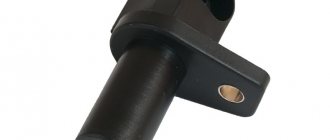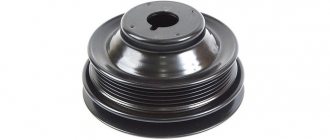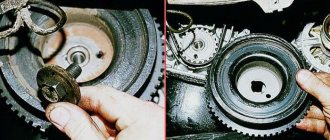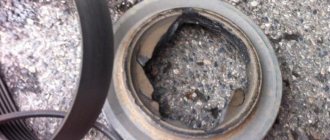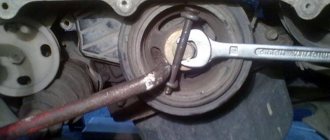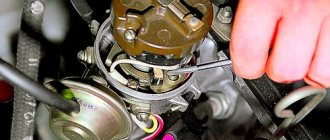The crankshaft pulley is a part that at first glance may seem unimportant for the car. In fact, this device plays a vital role in ensuring the functionality of many vehicle systems. By itself, no shaft is capable of functioning. For this purpose, the car has special elements that transmit torque to other components. The crankshaft pulley is just one of these links. During operation, problems can occur with it, like with any other element. In this material, we will consider the types of pulleys, where they are installed and how to replace them.
Types of pulleys
As we wrote earlier, automakers can introduce various pulleys into the design of their cars. Although a part from a car of one brand may not be externally different from a part from another, there is always a difference. And the point here is not only in form, but also in balancing . However, pulleys are divided into several types. Namely:
- Under the V-belt. It is pulleys for such a belt that are installed on the vast majority of cars, trucks, and sports cars. The belt pulley is the same one-piece or all-welded part mentioned above. A key on the crankshaft prevents the pulley from turning, and the part itself is secured with a nut (in rare cases, a bolt);
- Toothed pulley. Modern timing belts do not always use a chain drive. In order to facilitate the entire system, the designers decided to use special belts. The toothed pulley has teeth on its outer rim that engage grooves on the inner surface of the belt. Despite the apparent vulnerability of the teeth, they hardly wear out;
- Damper pulley. Toothed pulleys made it possible to solve the problem of mismatched rotation angles, and damper pulleys make it possible to solve the problem of impulse mechanical influences that inevitably arise in the gas distribution system of a car. Such a pulley has a rubber layer that separates the working disk and the inner race - the damper.
All three pulleys have their advantages and disadvantages. It is important to understand that the design of the pulley also depends on how the elements adjacent to them are arranged and what are the features of their operation. The same damper pulleys made it possible to solve the problems of mechanical impacts and vibrations that occur when starting the engine and changing the frequency at which the crankshaft rotates. At the same time, the pulley damper fails quite quickly. Let's pay a little more attention to this.
Damper or solid pulleys?
In practice, it has been proven that it is quite simple to neutralize engine vibrations using a torsional vibration damper . Such dampers are widely used in diesel cars, while they are not so common in gasoline cars (usually in trucks and buses). On passenger cars, the crankshaft pulley is usually all-metal, which is its Achilles heel - vibrations freely transmitted from the engine lead to rapid wear of the pulley, as a result of which it does not reach the 10 years of operation guaranteed by the manufacturer. The advantages of the damper pulley are:
- Engine noise is reduced;
- The amplitude of torsional vibrations is reduced by 2-5 times - this increases the survivability of the pulley and adjacent units (only the damper wears out quickly);
- Shock loads are effectively absorbed;
- Increases fuel efficiency and environmental friendliness of the vehicle.
Spare parts for Renault 10
Towing cables
1.3
Spare parts for Renault 10
Steering rack/mechanism oil seal (see standard sizes) 1.1
Contrary to the assurances of some car enthusiasts, the damper cannot seriously reduce the load on the belt. However, a pulley with a damping insert has several more significant disadvantages:
- It is more expensive than an all-metal pulley;
- The damper becomes unusable over time (the rubber insert cracks or breaks).
Despite the disadvantages, damper pulleys perform better than non-damper pulleys. One of their problems is the need for preventative replacement . As soon as the rubber element cracks, the entire pulley ceases to perform its main tasks. Please note: Modern fuel efficient engines are built to fit damper pulleys only.
And let’s immediately touch on another question: what is a lightweight pulley? This is the name given to a part made of aluminum alloy. Usually it has a damping element, but exceptions sometimes occur. For example, in the USA, the alloys from which some automobile engine parts are made are called alloys for aviation applications. They are durable, resistant to temperature changes and very lightweight. Aluminum pulleys introduce peculiarities into the operation of the engine (it slows down faster after the driver releases the gas pedal) and copes worse with vibrations (solved by installing a damper).
Crankshaft pulley and its purpose
Any modern internal combustion engine has additional equipment: generators, pumps, compressors, cooling system pump. For all these mechanisms to work, it is necessary to transmit torque from the crankshaft to the engine equipment. To achieve this, car manufacturers use belt drives. A pulley or several pulleys are installed on the toe side of the crankshaft (from the front of the engine). The mating pulleys of engine components and assemblies are mounted on the engine block, the rotation of which is ensured by a belt drive. The pulley is attached to the crankshaft using a key connection and secured with a bolt or nut.
Structurally, a pulley is a flat wheel with a special channel on the end surface where the belt is placed. Provided there is sufficient tension, the belt engages the pulley and the belt drive begins to operate. Such pulleys are made of steel, aluminum, cast iron.
Purpose and device
The crankshaft pulley is a disk-shaped product. In the center there is a special hole, with the help of which the entire part can be mounted on the front part of the crankshaft. There is also a small groove intended for installing the so-called key. There are grooves on the outer part of the pulley. As the car enthusiast has probably already guessed, the grooves are made for drive belts.
In the vast majority of cases, the outer part of the pulley is a disk with a periphery, which are connected by especially durable rubber. You can notice small notches and pits on the pulley - they are needed so that the part, which is mostly a heavy metal product, is balanced . A well-balanced pulley copes with the following tasks:
- Belt cooling;
- Depreciation in cases where the nature of rotation changes;
- Transferring energy to attachments through a belt drive;
- Balancing the crankshaft as it works.
Ideally, a crankshaft pulley lasts ten years. The duration of operation is influenced by many factors, including the nature of the operation of the power unit and the condition of adjacent components. The pulley is not a serviceable part, and ideas about its repair are far from reality - the part needs to be restored and balanced, which can sometimes be as difficult as turning a new product from a solid metal blank. When making pulleys at the factory, casting and filigree turning are used, which not every craftsman can handle. So if the crankshaft pulley fails , you need to get a new one.
Where is the crankshaft pulley located?
Basically, when lifting the hood lid, it is quite difficult to notice this design. The fact is that the pulley is located behind the generator and is therefore not noticeable. However, if you look down into the place of the belt, you can see a disk fixed to the shaft by a hub - this will be the part you are looking for. In order to remove the pulley, the driver will need to perform the following manipulations:
- Loosen the locking bolt on the generator;
- Loosen the tension bolt and lower the belt slightly;
- Disconnect the antifreeze reservoir;
- Remove the power steering belt;
- Using a wrench, unscrew the fastening element securing the pulley.
- Difficulty removing the toothed pulley
Removing the bolt holding the gear-type crankshaft pulley will be quite problematic without a special tool. Since its thread is cut in such a way that the direction of unscrewing completely coincides with the torque of the shaft, this is difficult to do. For these purposes, a wrench of size 19 is usually used, with which you will need to unscrew the part of interest against the rotation of the shaft. However, even if you managed to dismantle the crankshaft pulley, you cannot say that at this stage all work is considered completed. The fact is that the hub usually sits quite tightly on the shaft, and a special key protects it from accidental slipping. To dismantle it, you can use a special puller or aerosol lubricant. Under their action, the crankshaft pulley hub will spontaneously swing with thrust towards itself.
You can learn how to unscrew the nut on the crankshaft pulley from this video: Published: April 15, 2021
Conclusion
The crankshaft pulley is definitely not a part you should skimp on. Purchasing analogues from suppliers for the conveyor is acceptable. It is easy to select this part, guided by the car data or catalog number. Beware of fakes! They are easily betrayed by poor quality packaging, poor quality of work with metal and rubber, as well as inconsistency of codes and concealment of important information from the buyer. Usually the country of manufacture of the counterfeit is not indicated. And remember: there are no eternal dampers. If the description of a damper pulley states that the damper itself is eternal, then the pulley simply may not have one - this is a rare, but still common, scheme to deceive buyers online.
Why is it difficult to remove the crankshaft timing belt?
In the absence of a special tool, removing the bolt holding the crankshaft toothed pulley is very problematic, since the thread is cut so that the direction of unscrewing coincides with the torque of the shaft when the engine is running. However, this is precisely the way out of the situation. All you need is a long wrench with a 19-mm head (can be extended with a piece of pipe), which rests against the ground against the rotation of the shaft. We carry out small preparatory work - we place wedges under the front wheels, and disconnect the connector on the ignition coil. For what? To use the starter as a mechanical force applied to the bolt.
So, we have done everything to prevent the car from accidentally starting and moving away. Now we ask everyone present to move away, while we ourselves climb into the cabin (do not leave your legs sticking out) and sharply, but briefly, turn the ignition key to start. If an attempt fails, do not despair and repeat. Usually the second time, less often after the 5th or 6th attempt, the bolt turns. Now you can proceed to the next step - removing the pulley hub from the shaft, taking into account that it fits tightly and is held in place by a key. When you need to tighten the bolt back, you either need to put a lot of force into tightening it, or still find an air impact wrench by then.
Functions of the crankshaft pulley
Braking distance of a car: everything you need to know
The crankshaft pulley is one of the parts of the crankshaft of a car engine, which is attached to the front output (protruding beyond the engine crankcase) part of the shaft (toe) and, using a special toothed belt (in some engines, chains) synchronizes operation of the engine crankshaft and camshaft. In addition, the crankshaft pulley, through the timing belt, also transmits torque (in fact, provides energy) to a number of devices of the so-called “attachments” of the car engine:
- generator
- engine coolant pump
- power steering pump
- air conditioner
The crankshaft pulley also performs (along with the flywheel and balancers) the functions of damping vibrations and shocks of the crankshaft. During the production process of pulleys, they all undergo special balancing. As you can see, a number of important vehicle mechanisms, including the engine itself, depend on the trouble-free operation of the crankshaft pulley. If there is no strictly synchronous operation of the crankshaft and camshaft, the engine will not operate normally.
That is why every car owner is faced with the requirement to regularly replace the crankshaft pulley complete with the timing belt (and, as a rule, the coolant pump roller). For each car model, there is a certain frequency for replacing the crankshaft pulley and timing belt. Wear and stretching of the timing belts, wear of the crankshaft pulley or pump roller can lead to engine malfunction, and in the worst case, to a break in the timing belt with subsequent damage to the entire crank group of the engine. Therefore, regular maintenance and replacement of the timing belt and crankshaft pulley should be taken seriously.
Types and design features of crankshaft pulleys
Engines use two main types of crankshaft pulleys, which differ in design and purpose:
— Grooved pulleys for V-belt transmission; — Toothed pulleys for a toothed belt.
Grooved pulleys are a classic solution that has been used on internal combustion engines since their inception. The outer surface of such a pulley has one or more V-shaped grooves, into which a belt of the appropriate shape (V-ribbed or poly-V-ribbed) fits. Such pulleys are used only in V-belt drives, in which there is no need for precise alignment of the crankshaft and units relative to each other. These transmissions include driving the water pump, alternator, air conditioning compressor, air compressor, fan and timing pump.
Toothed pulleys are a modern solution that has been used on engines for the last two to three decades. Such pulleys are used in transmissions with timing belts, which replace the timing chain drive. The toothed pulleys of the crankshaft and units and the toothed belt connecting them ensure a certain position of the units relative to each other. In most cases, a toothed pulley is used to drive the timing belt and water pump, and the remaining units are driven by a separate V-belt drive.
How to choose
When choosing a toothed pulley, you should pay attention to the processing class, the distance between the teeth and the manufacturing shape. The tooth surfaces and the belt are subject to constant loads, so high demands are placed on the quality of cutting and processing. Cutting teeth is carried out in several stages on a milling machine or devices designed specifically for the manufacture of these parts. Cast iron products are somewhat different from other varieties; they are cast in forms that completely replicate finished pulleys for timing belts and are processed using a milling machine.
The flanges on the pulley can be either absent or located on one or both sides. They are fixed in three ways:
How to remove the crankshaft pulley
The operations described above are the most complex; all subsequent steps can be completed without much effort. In this case, all stages must be carried out as carefully as possible so as not to damage important segments of the car. To remove the crankshaft pulley, you need to perform a number of additional operations. They include the dismantling of related components and parts.
- First you need to release the locking bolt and loosen the tension bolt. This will allow you to easily dismantle the generator.
- After performing these manipulations, lift the front of the car and remove the right front wheel.
- In the upper engine part, you need to remove the air filter and the engine mud shield. To fix the crankshaft in one position, open the plug on the side of the clutch and insert a pry bar into the resulting opening. Any other lever that can jam the flywheel teeth will do.
- Now you can begin to solve the most basic task - unscrewing the pulley bolt. We put a tool of the appropriate size with a reinforcing lever on the fastening element.
Many people are interested in what thread is on the crankshaft pulley. The answer is simple, unscrew the bolt or nut counterclockwise.
Questions about replacing and repairing the crankshaft pulley
The crankshaft pulley is a reliable and durable part, but over time it may become damaged and fail. If wear is detected on the toothed pulley, as well as in the event of cracks, breaks, deformations and other damage, the pulley should be dismantled and replaced with a new one. Removing the pulley may also be necessary when performing repair work on the engine.
The process of replacing the crankshaft pulley depends on the type of its mounting. The easiest way to remove a pulley with bolts is to simply unscrew the bolts, while fixing the crankshaft, preventing it from turning. Dismantling a toothed pulley using one bolt is somewhat more complicated and generally looks like this:
- Secure the car by placing chocks under the wheels, in the case of a gasoline engine, remove the connector from the ignition coil (so that the starter turns, but the engine does not start), in the case of a diesel engine, remove the connector from the injection pump fuel supply valve;
- Treat the bolt with some means that will help remove the fastener from its place without breaking it;
- Place a long-handled wrench on the bolt; it should reach the floor, or additionally use a pipe;
- Crank the engine with the starter - in this case the bolt should turn. If you don’t succeed the first time, you can repeat it;
- Unscrew the bolt;
- Using a special puller, remove the pulley from the crankshaft toe.
It should be noted that to access the pulley in cars with a longitudinal engine, it is better to use the inspection hole, and in cars with a transverse engine, you will have to remove the right wheel.
When breaking the bolt, you should be careful - it is screwed in with great force, so the risk of its breakage is quite high. It is recommended to remove the pulley from the crankshaft using a special puller, although you can also use a simple mounting blade, but in this case you should also be careful. Some pulleys have special threaded holes into which you can screw bolts and remove the pulley. However, in this case, a steel sheet should be placed under the bolts being screwed in, since the bolt may push through the front wall of the engine block or other parts located underneath it.
Installation of the crankshaft pulley is carried out in the reverse order. However, difficulty may arise here, since the pulley is tightly installed on the toe of the crankshaft, which requires great physical effort. The pulley seating area can be treated with grease to facilitate its installation.
If the crankshaft pulley is correctly replaced, all engine components will operate normally, ensuring reliable operation of the entire power unit.
A pulley is a drive wheel for transmitting or receiving torque from a drive belt. Belt drives have been used by people since ancient times; in the Middle Ages, their widespread use in village spinning wheels began. With the beginning of the industrial revolution, every machine was equipped with them. Nowadays, pulleys are widely used in internal combustion engines, machine tools, household appliances, and hand-held power tools. Drive belts and wheels have been standardized - this allows them to be interchangeable. The rules and techniques for depicting parts in drawings have also been standardized.
Dismantling
In order to remove the old toothed pulley, it is necessary to remove the cover that hides the wires of the units, thus providing free access to the motor parts that require replacement. Next, the tension of the drive chain is released. After which the tank with antifreeze liquid and the electric generator are removed. If the car is equipped with power steering, it is necessary to remove the belt for this system.
Next, all that remains is to remove the mounting bolt that secures the toothed pulley to the crankshaft, but difficulties may arise here due to the direction of the thread. While the engine is moving, the bolt is constantly tightened, so at this stage of the work a pneumatic impact wrench may be required if the manual effort is not enough.
In the absence of special tools that significantly simplify the task, it is recommended to secure a wrench to the bolt to prevent it from turning. During work, the vehicle must be on jacks or with the drive wheels removed. This is necessary to ensure that the transport does not move from its place. The bolt will be unscrewed by sharply turning the ignition key, while the starter will make several turns and all that remains is to remove the bolt. After replacing the pulley, all parts are installed in the reverse order.
Application of pulleys
Wedge drives are one of the most widely used in a wide variety of mechanisms and devices with high torque and angular velocity. First of all, these are internal combustion engines. In addition, V-belt pairs are used in areas such as:
- fans and air conditioners;
- compressor units, both piston and screw;
- transport systems of buildings: elevators, escalators, travelators;
- agricultural machinery;
- road construction equipment;
- mining machines;
- industrial technological installations;
- machines;
- Appliances;
- hand power tools;
and in many other industries.
Gear drives are used in cases where it is necessary to transmit significant torque without slipping. The toothed belt drive does not require much tension for good traction. It produces significantly less radial load on the axle than other belt drives.
The following drives are used in:
- automobile engines, for the gas distribution mechanism;
- power drives of machine tools and industrial mechanisms;
- in technological installations of the food, pharmaceutical, chemical industries.
Poly V-ribbed pulleys do an excellent job in so-called serpentine transmissions, when one drive supplies rotational energy to many consumers, and at the same time follows a very winding trajectory. Poly V-ratio transmissions allow you to transmit significant torques and achieve high speeds without increasing dimensions.
They are used both in heavy engineering and in the production of household appliances.
CVT drive wheels are used wherever it is necessary to smoothly change speed and torque without stopping rotation or removing the load. They are popular in areas such as:
- transmissions of cars, motorcycles, and other wheeled vehicles;
- conveyors;
- precision machines for processing metal, wood and other materials;
- agricultural machinery.
A modern variator surpasses both manual and hydraulic transmissions in its performance characteristics.
Flat drives are used where it is necessary to transmit rotation over significant distances (up to 7-9 m) and absorb shocks, jolts and other dynamic loads transmitted from the drive shaft to the driven shaft (or in the opposite direction). They apply:
- in pressing and other forging equipment;
- in sawmill drives;
- in technological equipment of the textile industry;
- in powerful centrifugal pumps.
Round belt drives are used for light-duty transmissions in precision instruments, consumer electronics and appliances.
They also easily intersect and, with the help of additional passive pulleys, allow you to connect the driven and drive shafts, located in different planes and at an angle to each other, and also change the direction of rotation.
Pulley removal
Unscrewing a fastening bolt or nut is only half the battle. Next you need to pull the pulley out of the shaft. The pulley cannot be removed easily by hand unless its seat is broken. In addition, if the pulley fits tightly onto the shaft, it is also secured against turning by a key.
There are special pullers for removing the pulley from the shaft. There are mechanical and hydraulic pullers.
The design of a mechanical puller is simple. Usually it has three legs, with which you need to hook the pulley itself, and rest the central rod against the shaft. After which, you need to rotate the rod, the legs will straighten and pull the pulley towards you.
There are even simpler pullers that you can make yourself.
If there is no removable device for the pulley, then you can use pry bars. If one person is filming, then take turns, moving it a little on each side so that there is no distortion. If there are two, then at the same time, from different sides, the pulley is pressed out from the crankshaft with a sharp movement.
It also happens that when using a puller, the walls of the pulley grooves cannot withstand and break off. Therefore, when using pry bars, they must be engaged as close to the shaft as possible.
Pulley malfunctions and checking their condition
The pulley and belt drives operate by friction between the contact surfaces, so a common reason for replacing a pulley is wear out of the working plane. Due to dynamic loads, the metal of the pulleys cracks and chips.
Another typical problem for such parts is key play in the crankshaft keyway. The reason for this is wear on the landing planes of the pulley with the shaft. The pulley fastener with such a malfunction gradually unscrews due to vibrations, increasing the play more and more.
Prolonged operation of the crankshaft with a “loose” pulley will lead to wear and tear of the keyway itself and unscrewing of the crankshaft pulley. Next, the entire assembly rotates on the seat, destroying the key joint, the pulley housing and the crankshaft itself. If a crankshaft pulley is torn off on your engine, there is a high probability that the entire crankshaft will need to be replaced.
Severely damaged crankshaft pulley
In order to determine the condition of the crankshaft pulley, you must:
- remove the pulley belts, inspect its edges and body for damage, cracks, wear;
- shake the pulley; if there is critical play, the assembly must be disassembled and inspected for wear and damage;
- Usually, repair instructions contain the dimensions of permissible wear of parts, distances to the nearest engine components. Checking these dimensions will help determine the suitability of the pulleys for further use.
Types of pulleys for crankshaft
Almost all mechanisms use energy obtained from the rotation of the crankshaft to operate. If the rotation of the wheels is ensured by an entire system, then a crankshaft pulley is used to operate the timing belt and other important elements. There are several types of such devices:
- Crankshaft with a pulley for a V-belt;
- Toothed pulley;
- Damper pulley.
Domestic car brands are equipped with a belt drive. The pulley for such a belt has a one-piece design, and the groove itself completely repeats the configuration of the V-belt. The gear design uses a belt rather than a chain. It is used on most modern cars. On minibuses and light-duty vehicles, a pulley with a rubber layer (damper) is used.
Pulley design
For the manufacture of belt drive pulleys, steel, cast iron, light alloys, wood and plastics are used. The outer part of the pulley with the belts installed is the rim, and the central part placed on the shaft is the hub. To connect the rim to the hub, spokes or a disk are used. If it is possible to put the pulley on the shaft from the end, it is made one-piece, otherwise it is made detachable. As a rule, the connector is made along the spokes.
For flat belt pulleys, the rim may be cylindrical or slightly convex. The convexity is provided in order to center the belt. Since a bulge on the rim negatively affects the life of the belt, usually only the drive pulley has a bulge on the rim. For V-belt drive pulleys, the rim is equipped with wedge-shaped grooves.


